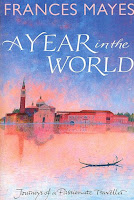 |
| The roofs of Óbidos |
In 2006, the American novelist, Frances Mayes (born in 1940) published a travel memoir book called ‘A Year in the World’. She is both a poet and an essayist, and in this account, she related her stay at Óbidos. The author is best known for other bestsellers like ‘Under the Tuscan Sun’ or ‘Bella Tuscany’.
At the time when I read ‘A Year in the World’, I was already living in Southeast Asia (I think it was when I was in Manila) and anything regarding the Mediterranean sounded exotic! But little did I know that one day, I would come back to Portugal on many occasions and that I would even live there! In the chapter dedicated to Portugal, Frances Mayes describes Óbidos:
“A walled and white town on a hill crowned by a castle and tower, Obidos’s beauty has earned it a stop on every traveler’s itinerary. […] The houses are appealing, bedecked with flowers and the whitewash often trimmed with sunny yellow borders.” (p.133)
And also: “Some distance restores the original enchantment of Óbidos. Moorish porches, stone steps up and down passageways, and the moon-white houses in the early morning certainly cast their spell. And anywhere the scent of orange blossom drifts.” (p.135)
 |
| Not just a house door |
It is going to be hard to try to describe Óbidos after what we have read! What we can say is that three main features characterize this lovely town: it is on a hill, it is historical and it is beautifully kept to its original flavor. Needless, to add that it is a Portuguese gem of a town.
 |
| On the main street |
On the expressway from Lisbon to Porto, as you approach the coastal town of Nazaré, you get the first glimpse of Óbidos with its castle on top of a hill. This hilltop community is surrounded by a fortified wall that dates back to the Moorish area. You do not drive through the town, so you must park your car at the entrance and keep on walking through its steep alleys in order to reach the main street. The name Óbidos derives from the Latin ‘oppidum’, which means a citadel. But even if the Romans and later the Moors left their footprints here, the town - like many other places in the country - was populated by the Celts, who once traded with the Phoenicians. And if you wonder why on earth did the Phoenicians come here for, this often forgotten side of History needs refreshing! The Phoenicians were bold seafarers. Not only did they sail beyond the Columns of Hercules but they went south down the African West coast as far the Gulf of Guinea and also northwards along the coast of Portugal, Spain, and France, past Brittany to Cornwall and the Scilly islands in search of tin, whose value was as good as the African gold.
This is just to update the historical past of Óbidos. But of course, today, what matters is the typical atmosphere that gives the town its typical charm. There are churches and some lovely facades adorned with plants and flowers. The main street has cafés and art shops. There is an amazing bookshop, whose walls are literally made of books that are definitely worth stopping at. And at the main entrance, the entire inside wall of the building is a huge 'azulejo' fresco.
 |
| At the main entrance |
It is all worth walking up to the top of the hill to get a full view of the town roofs or to get a glimpse of the back countryside past the city wall.
Óbidos is one of these fairy-tale European places that you can only experience by visiting the Old World.
Christian Sorand
 |
| Ceramic boutique |
 |
| The white & yellow... |
 |
| The white & blue. |
 |
| A refreshing yard |
 |
| Townhouses |
 |
| Small café |
 |
| Reptilian door-knockers |
 |
| Marine door-knockers |
 |
| A fabulous second-hand bookshop |
 |
| An arcade on the main square |
 |
The church on the main square
|
 |
A classy façade
|
 |
Backcountry view
|
 |
Panoramic view of Óbidos
|
 |
An artist's main door
|
 |
| Just a window! |





















No comments:
Post a Comment